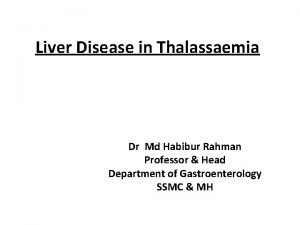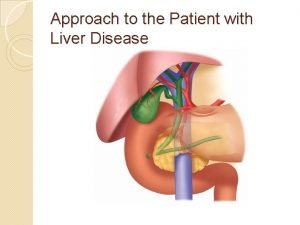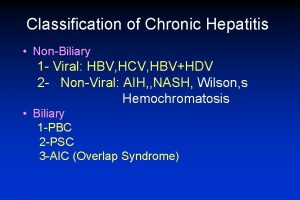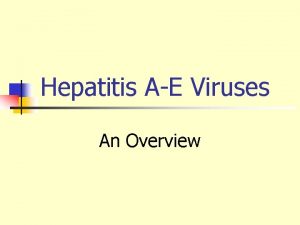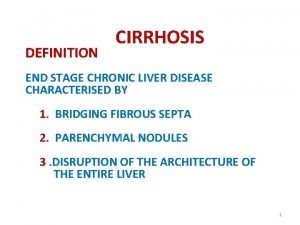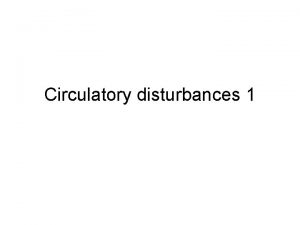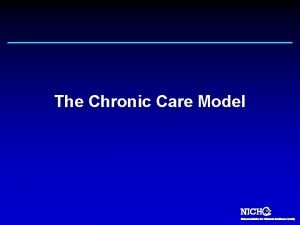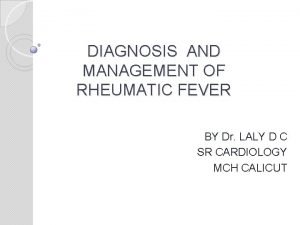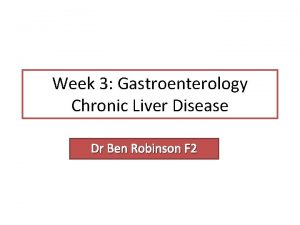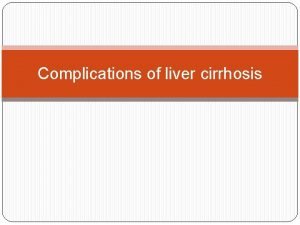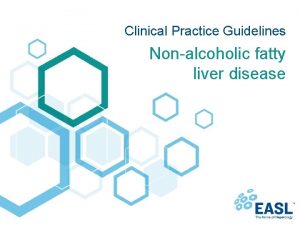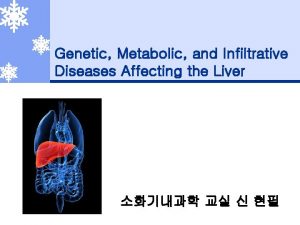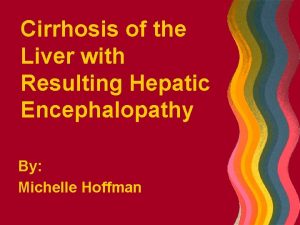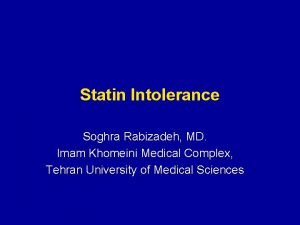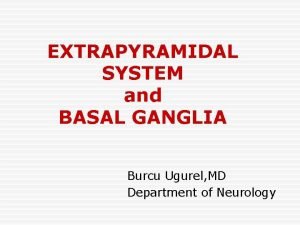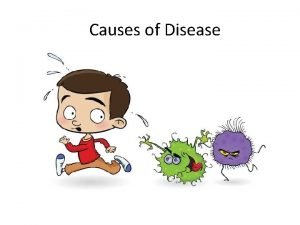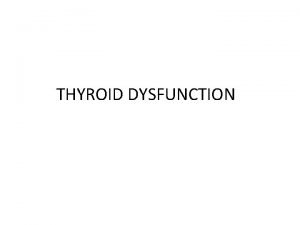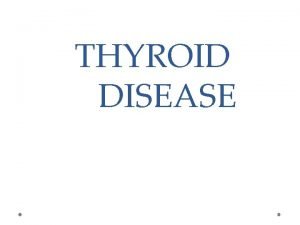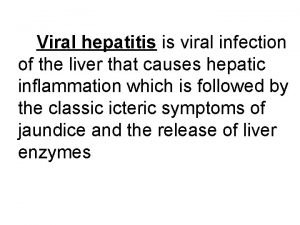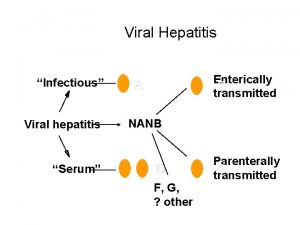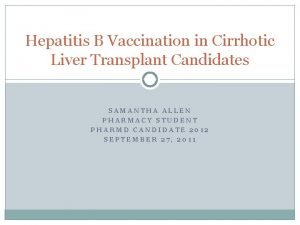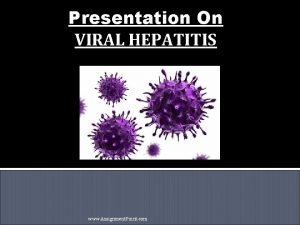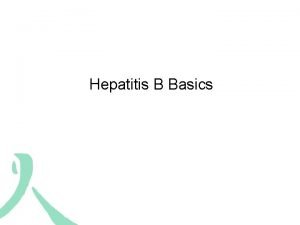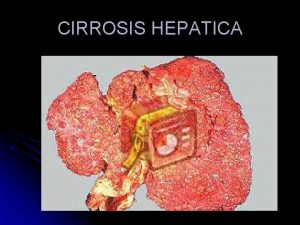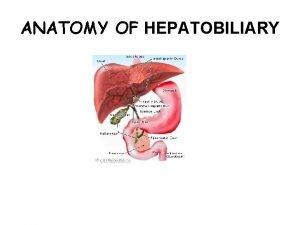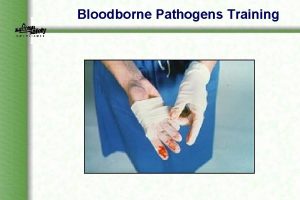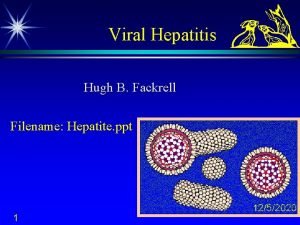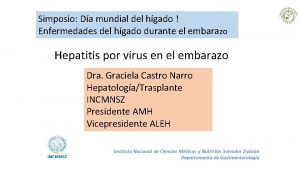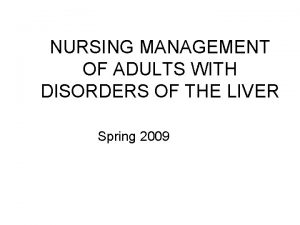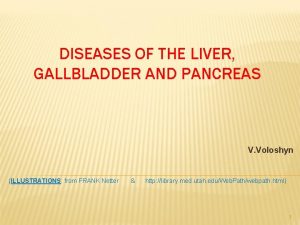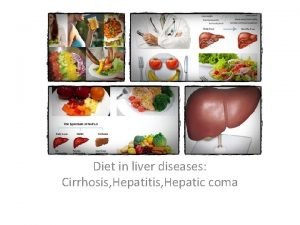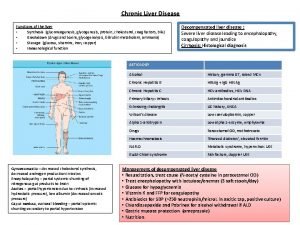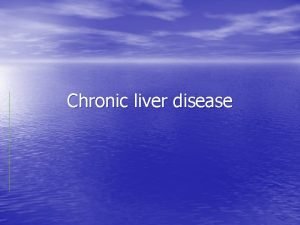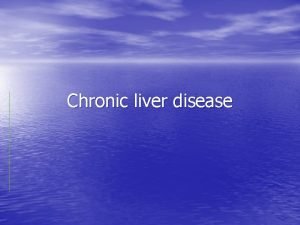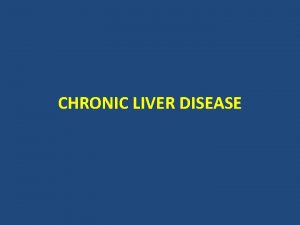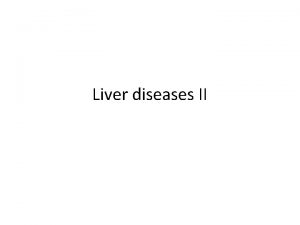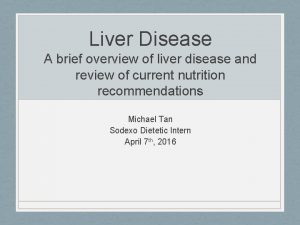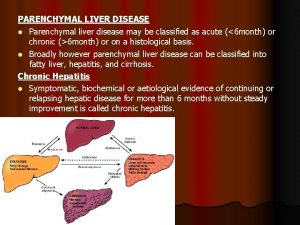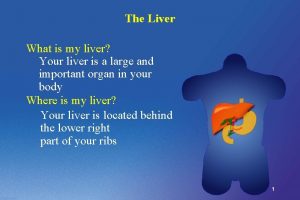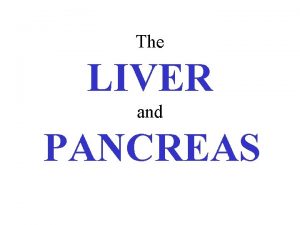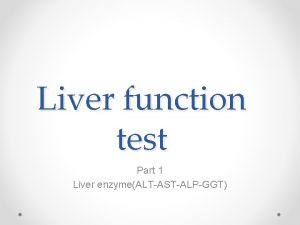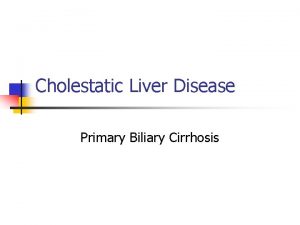Hepatitis Primary causes of chronic liver disease Hepatitis




























































































- Slides: 92

Hepatitis


Primary causes of chronic liver disease

Hepatitis (Liver-Attacking) Viruses Hepatitis A – fecal/oral, contaminated food, vaccine available Hepatitis B – blood, semen, vertical (mother-child), vaccine available Hepatitis C – blood (IV drug use, transfusion, organ donation, unsterile injecting equipment, sexual intercourse) Hepatitis D – survives only in cells co-infected with hepatitis B Hepatitis E* – contaminated food or water, fecal/oral *causes short-term disease and is not a chronic carrier state


Viral Hepatitis • When they occur, the signs and symptoms of viral hepatitis can include: – – – – – Fever Fatigue Loss of appetite Nausea Vomiting Abdominal pain Jaundice Dark urine Clay-colored stool Joint pain

Viral Hepatitis

Viral Hepatitis • Viral hepatitis is the leading cause of liver cancer and the most common reason for liver transplantation • In the United States, an estimated 1. 2 million Americans are living with chronic Hepatitis B and 3. 2 are living with chronic Hepatitis C – Many do not know they are infected • Each year an estimated 21, 000 persons become infected with Hepatitis A; 35, 000 with Hepatitis B, and 17, 000 with Hepatitis C

Hepatitis A

Hepatitis A Epidemiology

Hepatitis A Epidemiology Prevalence of antibody to hepatitis A virus, 2010 Source: CDC Yellow. Book

Hepatitis A • Hepatitis A has an incubation period of approximately 28 days (range: 15– 50 days) • HAV replicates in the liver and is shed in high concentrations in feces from 2 weeks before to 1 week after the onset of clinical illness • HAV infection produces a self-limited disease that does not result in chronic infection or chronic liver disease • Humans are the only natural host

Hepatitis A Features Incubation period: 28 -30 days Symptoms: None (especially children <5 years old) Fever Malaise Anorexia Nausea Jaundice Fulminant death (acute) Likelihood of clinical disease increases with age Duration: 25 -30 days

Hepatitis A Acute Illness • In children aged <6 years, 70% of infections are asymptomatic; if illness does occur, it is typically not accompanied by jaundice. • Among older children and adults, infection is typically symptomatic, with jaundice occurring in >70% of patients. • Symptoms usually last less than 2 months, although 10%– 15% of symptomatic persons have prolonged or relapsing disease for up to 6 months.

Diagnosis, Treatment & Reservoir of Hepatitis A Diagnosis: Anti-Ig. M detectable 5 -10 days before symptoms; disappears by six months Anti-Ig. G – convalescent, life-long, confers protection Treatment: Supportive

Hepatitis A Diagnosis


Transmission & Risk Groups for Hepatitis A Transmission: fecal-oral, contaminated food, water, sexual Risk groups: international travellers, MSM, child care-givers, persons with chronic liver disease, injection drug users Period of communicability: 1 -2 weeks before symptoms, to one week after onset of jaundice Endemic areas: Central & South America, Middle East, Asia, and western Pacific Reservoir: Humans


Hepatitis A Epidemiology






Hepatitis A Prevention • Hepatitis A vaccine is the best protection. • Good sanitation measures are essential for preventing environmental contamination. • Good personal hygiene is also essential for prevention and control including: – Hand washing with soap: • After using the bathroom • After changing a diaper • Before preparing and eating food

Hepatitis B • Hepatitis B is caused by infection with the Hepatitis B virus (HBV), the prototype member of the hepadnavirus family – HBV is the only human representative of this family. – It has a circular DNA genome of 3. 2 kb • Currently, eight genotypes (A−H) are identified by a divergence of >8% in the entire genome

Hepatitis B Characteristics • A Hepadnaviridae – partially double-stranded DNA virus • HBs. Ag – stimulates protective antibodies, a marker for current infection • HBc. Ag – localized within liver cells, identifies acute infection, anti-HBc. Ag persists for life and is a marker of past infection • HBe. AG – a marker of active replication and infectivity

Hepatitis B



Hepatitis B Source: J Viral Hepat. 2010 Apr; 17(4): 229 -35. Hepatitis B virus: origin and evolution.

Hepatitis B Epidemiology • Worldwide, HBV is the primary cause of liver cancer – For males, it is the third leading cause of cancer mortality – For females, it is the sixth leading cause of cancer mortality

Hepatitis B Epidemiology • An estimated 800, 000– 1. 4 million persons in the United States have chronic HBV infection. • Chronic infection is an even greater problem globally, affecting approximately 350 million persons. • An estimated 620, 000 persons worldwide die from HBV-related liver disease each year.

Hepatitis B Epidemiology • The incubation period from the time of exposure to onset of symptoms is 6 weeks to 6 months. • HBV is found in highest concentrations in blood and in lower concentrations in other body fluids (e. g. , semen, vaginal secretions, and wound exudates). • HBV infection can be self-limited or chronic.

Hepatitis B In adults, only approximately half of newly acquired HBV infections are symptomatic, and approximately 1% of reported cases result in acute liver failure and death.

Hepatitis B Diagnosis • Hepatitis B is detected by looking for a number of different antigens and antibodies: – Hepatitis B surface antigen (HBs. Ag): • A protein on the surface of HBV; it can be detected in high levels in serum during acute or chronic HBV infection. • The presence of HBs. Ag indicates that the person is infectious. • The body normally produces antibodies to HBs. Ag as part of the normal immune response to infection. • HBs. Ag is the antigen used to make Hepatitis B vaccine.

Hepatitis B Diagnosis • Hepatitis B is detected by looking for a number of different antigens and antibodies: – Hepatitis B surface antibody (anti-HBs): • The presence of anti-HBs is generally interpreted as indicating recovery and immunity from HBV infection. • Anti-HBs also develops in a person who has been successfully vaccinated against Hepatitis B. – Total Hepatitis B core antibody (anti-HBc): • Appears at the onset of symptoms in acute Hepatitis B and persists for life. • The presence of anti-HBc indicates previous or ongoing infection with HBV in an undefined time frame.

Hepatitis B Diagnosis • Hepatitis B is detected by looking for a number of different antigens and antibodies: – Ig. M antibody to Hepatitis B core antigen (Ig. M anti-HBc): • Positivity indicates recent infection with HBV (≤ 6 months). • Its presence indicates acute infection. – Hepatitis B e antigen (HBe. Ag): • A secreted product of the nucleocapsid gene of HBV that is found in serum during acute and chronic Hepatitis B. • Its presence indicates that the virus is replicating and the infected person has high levels of HBV.

Hepatitis B Diagnosis • Hepatitis B is detected by looking for a number of different antigens and antibodies: – Hepatitis B e antibody (HBe. Ab or anti-HBe): • Produced by the immune system temporarily during acute HBV infection or consistently during or after a burst in viral replication. • Spontaneous conversion from e antigen to e antibody (a change known as seroconversion) is a predictor of longterm clearance of HBV in patients undergoing antiviral therapy and indicates lower levels of HBV.

Hepatitis B Typical interpretation of serologic test results for hepatitis B virus infection Source: MMWR Recomm Rep. 2006; 55(RR-16): 1– 25.



Source: Ganem, D. , et al. (2004). N Engl J Med.














Hepatitis B

Hepatitis B Treatment • For acute infection, no medication is available; treatment is supportive. • For chronic infection, several antiviral drugs (adefovir dipivoxil, interferon alfa-2 b, pegylated interferon alfa-2 a, lamivudine, entecavir, and telbivudine) are available. – Persons with chronic HBV infection require medical evaluation and regular monitoring to determine whether disease is progressing and to identify liver damage or hepatocellular carcinoma.

Hepatitis B Elimination • CDC’s national strategy to eliminate transmission of HBV infection includes: – Prevention of perinatal infection through routine screening of all pregnant women for HBs. Ag and immunoprophylaxis of infants born to HBs. Agpositive mothers and infants born to mothers with unknown HBs. Ag status – Routine infant vaccination – Vaccination of previously unvaccinated children and adolescents through age 18 years – Vaccination of previously unvaccinated adults at increased risk for infection





Hepatitis C • Hepatitis C virus (HCV) infection is the most common chronic blood-borne infection in the United States; approximately 3. 2 million persons are chronically infected • By contrast to Chronic HBV, patients with chronic hepatitis C almost always develop HCC in the presence of established cirrhosis • The annual risk of HCC development in HCV patients with cirrhosis is in the range of 1– 4%, and an estimated 1– 3% of patients chronically infected with HCV will develop HCC after 30 years

Hepatitis C Characterisitcs • Flavivirus – small, enveloped, single-stranded RNA virus, six genotypes • Replicates in liver cells, lymphocytes and monocytes • Replicates >1 trillion progeny per day • Mutates rapidly (error-prone RNA polymerase) • Down-regulates stimulatory receptors on NK cells • Increases inhibitory receptors on NK and CD 8+ killer cells • Produces TGF-beta, which blocks activation of T cells and inhibits production of IFN-gamma

Hepatitis C Epidemiology • Transmission of HCV occurs through: – Percutaneous • • Injecting drug use Clotting factors before viral inactivation Transfusion, transplant from infected donor Therapeutic (contaminated equipment, unsafe injection practices) • Occupational (needlestick) – Permucosal • Perinatal • Sexual

Hepatitis C Epidemiology • The following persons are at known to be at increased risk for HCV infection: – Current or former injection drug users, including those who injected only once many years ago – Recipients of clotting factor concentrates made before 1987, when more advanced methods for manufacturing those products were developed – Recipients of blood transfusions or solid organ transplants before July 1992, when better testing of blood donors became available – Chronic hemodialysis patients – Persons with HIV infection – Children born to HCV-positive mothers

Hepatitis C Epidemiology Source: CDC DVH

Hepatitis C • Although only 850 cases of confirmed acute Hepatitis C were reported in the United States in 2010, CDC estimates that approximately 16, 000 new HCV infections occurred that year, after adjusting for asymptomatic infection and underreporting. • Persons newly infected with HCV are usually asymptomatic, so acute Hepatitis C is rarely identified or reported.

Hepatitis C Source: CDC DVH

Hepatitis C Natural History of Infection

Hepatitis C Prevalence of chronic infection with hepatitis C virus Source: CDC Yellow. Book 2012

Hepatitis C Source: Nature Reviews Gastroenterology & Hepatology 8, 69 -71 (February 2011)

Hepatitis C Diagnosis

Hepatitis C Diagnosis


Hepatitis C Diagnosis • Sixty to 70% of persons newly infected with HCV typically are usually asymptomatic or have a mild clinical illness. • HCV RNA can be detected in blood within 1– 3 weeks after exposure. • The average time from exposure to antibody to HCV (anti-HCV) seroconversion is 8– 9 weeks, and anti-HCV can be detected in >97% of persons by 6 months after exposure.

Hepatitis C Chronic Illness • 75 -85% of those infected with HCV will develop chronic infection. • 60 -70% of those infected with HCV will develop chronic liver disease. • 5 -20% of those infected will develop cirrhosis over a period of 20 -30 years • 1 -5% will die from the consequences of chronic infection (liver cancer or cirrhosis)

Hepatitis C Treatment • Interferon-based therapy is currently the standard of care for patients with chronic HCV, and has been proven to be effective in eliminating HCV. • Both conventional and pegylated interferon (IFN) therapy have been used widely, with the aim of achieving a sustained virological response (SVR).

Hepatitis C Prevention • Unlike HBV, there is currently no vaccine for HCV. • However, with the screening of HCV in blood transfusion services, transfusionrelated HCV infection has been lowered to almost zero.

Hepatitis C Prevention • It may be possible to develop a preventive vaccine for HCV: – 30% of persons clear the virus spontaneously – The genome of HCV is not integrated into the host genome – After HCV infection, CD-8 CTL responses and antibodies appear, but the “protective immune response” or critical epitopes are not known – Persons who clear HCV and become re-infected have low viral loads and are more likely to clear HCV

Hepatitis D • Hepatitis D (HDV), also known as "delta hepatitis, " is a single-stranded circular RNA virus structurally unrelated to the Hepatitis A, B, or C viruses • Hepatitis D, which can be acute or chronic, is uncommon in the United States

Hepatitis D • HDV is an incomplete virus that requires the helper function of HBV to replicate and only occurs among people who are infected with the Hepatitis B virus (HBV). • HDV is transmitted through percutaneous or mucosal contact with infectious blood and can be acquired either as a coinfection with HBV or as superinfection in persons with HBV infection.

Hepatitis E • Hepatitis E virus (HEV), the major etiologic agent of enterically transmitted non-A hepatitis worldwide, is a spherical, nonenveloped, single stranded RNA virus that is approximately 32 to 34 nm in diameter. • HEV is the sole member of the genus Hepevirus. – Two major species of the virus are recognized: • Mammalian HEV, a virus that causes acute hepatitis in humans and has a reservoir in pigs and possibly a range of other mammals • Avian HEV, causing big liver and spleen disease in chickens

Hepatitis E • Hepatitis E is a serious liver disease caused by the Hepatitis E virus (HEV) that usually results in an acute infection. • It does not lead to a chronic infection. • While rare in the United States, Hepatitis E is common in many parts of the world. • Hepatitis E is transmitted through the fecal oral route and outbreaks are usually associated with contaminated water supplies in countries with poor sanitation.

Hepatitis E Acute Illness • The incubation period following exposure to HEV ranges from 15 to 60 days (mean, 40 days). • Typical clinical signs and symptoms of acute hepatitis E are similar to those of other types of viral hepatitis and include abdominal pain anorexia, dark urine, fever, hepatomegaly, jaundice, malaise, nausea, and vomiting.

Hepatitis E • Most people with Hepatitis E recover completely. • The overall case-fatality rate is ≤ 4%. • However, for pregnant women, Hepatitis E is more serious and the disease is fatal in 10%– 30% of pregnant women, particularly those in their third trimester.

Hepatitis E Diagnosis

Hepatitis E Epidemiology • The highest attack rate is seen among persons aged 15 -40 years. – In most hepatitis E outbreaks, the highest rates of clinically evident disease have been in young to middle-age adults; lower disease rates in younger age groups may be the result of an icteric and/or subclinical HEV infection. • The case fatality rate overall is 1%-3%. – In pregnant women, the case fatality rate can be as high as 15%-25%. • HEV is found in the stool (feces) of persons and animals with hepatitis E. • HEV is spread by eating or drinking contaminated food or water. • Transmission from person to person occurs less commonly than with hepatitis A virus.

Hepatitis E Levels of Endemicity, 2010 Source: CDC DVH

Hepatitis E Prevention • A Hepatitis E vaccine was just approved for use (but only in China). • Good sanitation measures are essential for preventing environmental contamination. • Good personal hygiene is also essential for prevention and control including: – Hand washing with soap: • After using the bathroom • After changing a diaper • Before preparing and eating food
 Hepatitis c symptoms in men
Hepatitis c symptoms in men Stigmata of chronic liver disease
Stigmata of chronic liver disease Features of cld
Features of cld Peripheral stigmata of cld
Peripheral stigmata of cld Nonalcoholic fatty liver disease
Nonalcoholic fatty liver disease Liver defination
Liver defination Classification of chronic hepatitis
Classification of chronic hepatitis Hbv
Hbv Hep b mode of transmission
Hep b mode of transmission Pbc vs psc
Pbc vs psc Renal bruit auscultation
Renal bruit auscultation Stage 1 cirrhosis
Stage 1 cirrhosis Circulatory disturbances pathology
Circulatory disturbances pathology Hepatitis b transmission
Hepatitis b transmission Chronic granulomatous disease
Chronic granulomatous disease Jewish chronic disease hospital study pdf
Jewish chronic disease hospital study pdf Chronic kidney disease near atwater
Chronic kidney disease near atwater Nih scale
Nih scale Kate lorig chronic disease self-management
Kate lorig chronic disease self-management Developedbyed
Developedbyed Chronic disease
Chronic disease Chronic disease
Chronic disease Pneumonia
Pneumonia Chronic rheumatic heart disease
Chronic rheumatic heart disease Decompensated liver disease
Decompensated liver disease Why does liver disease cause splenomegaly
Why does liver disease cause splenomegaly Elisabetta bugianesi
Elisabetta bugianesi Inokuchi shunt
Inokuchi shunt Gennifer shafer liver disease
Gennifer shafer liver disease Cirrhosis
Cirrhosis Infiltrative liver disease
Infiltrative liver disease Liver cirrhosis stages
Liver cirrhosis stages Elevated liver enzymes causes
Elevated liver enzymes causes What is the primary function of the liver
What is the primary function of the liver Communicable disease and non communicable disease
Communicable disease and non communicable disease Parkinson's disease causes
Parkinson's disease causes What causes addisons disease
What causes addisons disease Upper lobe diversion
Upper lobe diversion Dopamine uses
Dopamine uses Causes of valvular heart disease
Causes of valvular heart disease Causes of valvular heart disease
Causes of valvular heart disease Monophyletic group
Monophyletic group Characteristics of protozoa
Characteristics of protozoa Giardia causes what disease
Giardia causes what disease Rheumatic heart disease causes
Rheumatic heart disease causes Proximate causation vs ultimate causation
Proximate causation vs ultimate causation Ultimate vs proximate causation
Ultimate vs proximate causation Mixoedema
Mixoedema Sick euthyroid
Sick euthyroid Tsh
Tsh Most common cause of primary amenorrhea
Most common cause of primary amenorrhea Primary succession causes
Primary succession causes Primary succession causes
Primary succession causes Primary and secondary causes of nephrotic syndrome
Primary and secondary causes of nephrotic syndrome Hepatitis comparison
Hepatitis comparison Hepatitis e
Hepatitis e Window period of hepatitis b
Window period of hepatitis b Gonorrhea
Gonorrhea Std refers to *
Std refers to * Dosis de hepatitis b
Dosis de hepatitis b Dieta hepatitis
Dieta hepatitis Hepatitis b vaccine series adults
Hepatitis b vaccine series adults Hepatitis c symtoms
Hepatitis c symtoms Biliary tree
Biliary tree Estigmas de hepatopatía crónica
Estigmas de hepatopatía crónica Hepatitis b
Hepatitis b Grados de encefalopatia hepatica
Grados de encefalopatia hepatica Vesica fellea
Vesica fellea Infectious canine hepatitis in dogs
Infectious canine hepatitis in dogs Hepatitis b panel
Hepatitis b panel Papillomitosis
Papillomitosis Neonatal jaundice
Neonatal jaundice Chronic pancreatitis nursing care plan
Chronic pancreatitis nursing care plan Score simplificado hepatitis autoinmune
Score simplificado hepatitis autoinmune Colestasis gestacional
Colestasis gestacional Hepatitis c symptoms in men
Hepatitis c symptoms in men Hepatitis types chart
Hepatitis types chart Hepatitis viral
Hepatitis viral Nursing management of liver abscess
Nursing management of liver abscess Gail lupica
Gail lupica Ano ang pagkakaiba ng hepatitis a at b
Ano ang pagkakaiba ng hepatitis a at b Hepatitis symptome
Hepatitis symptome Question one piece
Question one piece Alcoholic hepatitis
Alcoholic hepatitis Types of cirrhosis
Types of cirrhosis Hepatitis b cronica
Hepatitis b cronica Klasifikasi hepatitis a
Klasifikasi hepatitis a Hepatitis
Hepatitis The primary pigment colors are ____.
The primary pigment colors are ____. Acute blood loss anemia
Acute blood loss anemia Definition of chronic toxicity
Definition of chronic toxicity Flinders model
Flinders model Earthy look in chronic renal failure
Earthy look in chronic renal failure

